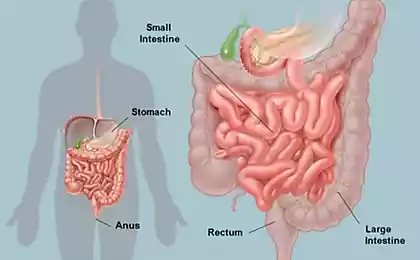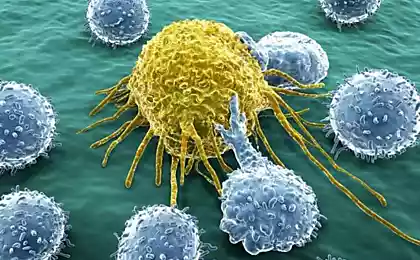630
About the benefits of delicious, or why a good cook is better than a good doctor
Don't know about others, but I'm always scared of public speaking dietitians about nutrition. When once again have to listen to learned students of the phrase that all spicy, fried, salted, pickled, spicy, and, equally, all sweets, flour, butter, in a word, all the yummy – bad. Literally it is "bad for Your health". Further categorically States that food should be well balanced in protein, fat and carbohydrates that triggers an automatic question, as a rule, remain without a clear answer: What does the term "balanced"?

The fact that all these norms of "balance" very different in different authors, in different medical schools, and even this outwardly simple question of how a normal protein in the different countries, the recommended consumption rates can vary by more than 2 times (Table.1)
Table 1. Recommended protein intake by the residents of different countries, aged 18-35 years old in moderate work
Country
The amount of protein (g/day)
Men
Women
UK
68
55
Hungary
80
80
Denmark
55
46
Italy
64
53
Spain
37
29 min
Canada
56
44
Netherlands
65
55
Norway
65
55
Russia
99
98 max
Poland
75
70
USA
56
48
Finland
60
50
Sweden
65
55
Japan
70
60
About the same range of good practice can be observed and on other components of our diet: fats and carbohydrates and for the same vitamins and minerals. And if someone claims that our "norm" of most "normal" for the average consumer all these figures do not have the slightest importance, when he has to lean over the window of a grocery store. And how can I trust nutritionists if they can't agree on norms so that these numbers are at least not very much different from each other? As a result, if anyone uses these numbers, so it is the distributors of food additives in Russia legalized form of fraud in obtaining money from the population in exchange for the promise of good health contained in the attached to these "additives" annotations.
And yet, what do we rely in selecting foods for dinner tonight? Most people will give the same answer: taste! And no matter how much we did not say dear nutritionists, what food should be assessed primarily from the point of view of calories, vitamins, minerals, and other "beneficial" ingredients, the priority evaluation of food has been and remains still, from the standpoint of its gustatory merits. And no matter how much we are not told about the beneficial properties of certain foods, for example fat-free curd, but curd cheese with 25% fat, will continue to occupy a worthy place in our diet. In fact, why do our taste buds returning to the dining table was not so much "useful" as, in fact, delicious?!
"All things, in his mouth crawled"
This may seem surprising, but it taste nutritionists do not like to do! This is partly understandable. After caloric content and food composition is easy to measure, to compare some numbers with others, to prove the differences, to bring the notorious balance and the like. But how to measure taste? And in what units can it be evaluated? There are no such units, only epithets.
Nevertheless, there were scientists who tried to find the answer to the perennial question: why should we thank the hostess not helpful, but just for a tasty treat?
Among those few, a special place is the eminent Russian physiologist Ivan Razenkov (1888-1954) (photo 1), which is still in the 20-ies of XX century was in charge of the Moscow Institute of nutrition laboratory of taste, digestibility and absorption and has been a faithful follower of his teacher, the academician I. P. Pavlov.
Flipping through the yellowed pages of reports on research conducted under the direction of I. P. Razenkova, I wonder the relevance of these carefully executed works. Take the ninth edition of the "Improvement of labor and the revolution of everyday life", which published the article by I. P. Razenkova and his staff for 1926. They were interested in smaller meals, predominantly of carbohydrate or protein, comparison of separate and joint use of meat and carbohydrate products, the comparison value of proteins of vegetable and animal food, the effect of food on the secretory activity of the stomach in various cooking methods and in various combinations. How can you not remember the current propaganda of the notorious "Kremlin diet", a separate food, vegan, raw food diet and other trendy modifications of nutrition, science-based assessment which actually was given already in early work razzenkovkoj laboratory.
However, the main direction, which was developed at the school of I. P. Razenkova, is the leading role of the Central nervous system in eating behavior and digestive processes in General. Without considering the nutrition is more than doubtful. In fact, digestion starts long before she entered the digestive tract. Smell and look delicious Ukrainian borsch and Georgian satsivi stimulate the secretion not only of saliva but also in gastric juice. These facts were established by I. P. Pavlov, and was among those discoveries for which the scholar received in 1904 the Nobel prize. In other words, the first team to start the digestion it gives the Central nervous system, based on the signals from the olfactory and gustatory analyzers. However, it also takes into account information received through the organs of sight and hearing: the sound of spoons on plates, for example, very conducive to the appetite, not to mention the kind of food and even a nice table setting, as indicated by I. P. Pavlov.
So, it is clear that in the first place should be the taste and aroma of the meals we offer. But, take your time, dear reader! Before proceeding to the main intellectual "dish" of today's story, we will talk about things not quite appetizing...
The Opening Of The I. P. Razenkova
In the laboratory I. P. Razenkova studied another interesting phenomenon – the so-called spontaneous gastric secretion. We at school know that before entering food into the stomach, and especially when she gets there, it secretes the gastric juice. It contains hydrochloric acid and digestive enzymes, primarily pepsin digesting proteins. However, in the laboratory of I. P. Razenkova, it was experimentally proved that the situation in the cavity of the gastrointestinal tract often develops in quite a different scenario.
Periodically in the stomach of the starving animals were discovered juice unusual composition: it was reduced acid content, up to its complete disappearance, but there were many nitrogenous substances. A detailed study showed that during the famine in the cavity of the gastrointestinal tract leak proteins: albumins and globulins of blood. (This process is called transsudate.)
Besides them, there are detected and conventional products of gastric secretion – enzymatic glycoproteins and other proteins, enzymes and fragments proferentem, formed during the activation, the proteins of the mucus, as well as proteins of epithelial cells detached from the mucosa of the gastrointestinal tract. Entering the cavity of the digestive system they are broken down by digestive enzymes and then absorbed as regular components of training. Their number was so great (около50 GW day), which corresponded to the lower limit of protein intake in food rations in some countries (see table). Every one of us can feel this activity of the digestive tract, when long-term lack of food, we have what is called "sucked in his stomach," and then we some time do not want to have. A more familiar name for this phenomenon – "hungry periodic activity of the gastrointestinal tract" – does not reflect the full extent of his biological nature. And it consists in the fact that for a complete renewal of body tissues decaying proteins must pass through the digestive tract, digested it and digested along with protein food. This is something that in recent decades used to be called endogenous nutrition.
The merit of I. P. Razenkova consists primarily in the fact that he clearly raised the issue of the implementation mechanism of the endogenous supply and formulated the answer in a General way. He believed that the basis of this phenomenon lies in the ability of the digestive tract to take from the blood brought to the tissue breakdown products, process them and return back into the blood in a manner acceptable to the digest form, thus providing the material for the constant renewal of tissues. It turns out that along with the well-known substance flow from the cavity of the digestive tract into the blood, there is another, oppositely directed flow of substances.
Spontaneous secretion, or endogenous nutrition, observed under a variety of conditions of the body: under the action of poisons under high temperature and low barometric pressure, with infectious lesions and relatively normal conditions such as blood transfusions. In other words, whenever in the body, strengthens the processes of tissue destruction (in the famine or infectious lesions) or the body is foreign protein (by blood transfusion or the introduction of a mixture of amino acids and glucose through a vein – the so-called parenteral nutrition), as well as certain other conditions in the stomach, the most extensive on the floor, there is an endogenous flow of protein substances. There they undergo the usual treatment with digestive enzymes for the breakdown and subsequent absorption, as if received from abroad.
These studies later became interested in other famous psychologists (A. D. Sinescu, G. K. Shlygin, H. Munro /H. Munro/ E. Nasse /Nasset E./ A. A. Aliyev and others) and presented their own data, which confirm the findings of I. P. Razenkova. For example, in 1962, E. Nasse not only proved experimentally the alignment of the amino acid composition of the intake, but even calculated that a person per day is allocated not less than gram of protein for every gram of protein food, i.e. a ratio of exogenous and endogenous proteins is 1:1. In 1985 A. A. Aliyev also found that the ratio of exogenous and endogenous proteins in the intestine of ruminants is 1:1, and the pigs can reach up to 1:2.
Thus, since the mid XX century it became clear that the stomach and intestines to digest not only food coming from outside, but proteins (and some fats and mineral substances) secreted in the cavity of the digestive tract from the internal environment of the body. Moreover, this phenomenon is observed when the limit stresses (hunger, fever), accompanied by intense breakdown of tissue, and in the average diet.
It becomes clear why we have no appetite in infectious diseases. In fact, until now, immunologists virtually ignore the question of what happens to the decaying inflammation of the tissue. The opening of the I. P. Razenkova gives it a simple and therefore the most reasonable answer: they come from the blood into the stomach, where it is digested along with exogenous food, and then their cleavage products are absorbed back into the blood. Likewise, the appetite disappears when performing heavy physical work, particularly in sports overload that does not fit with the hopelessly outdated concept of "caloric balance": say, how much energy expended, so many have to consume with food. With all the absolute correctness of the law of conservation of energy has long been required to clarify how it is carried out in biological systems. Professor A. arshavskii in the 30-ies of XX century was measured, the ratio of energy consumption and energy consumption at heavy physical work. It turned out that workers manually sawing the logs into boards, expend calories almost in two times more than consumed with food, and if they forced themselves to eat more, it simply could not work. Taking into account the contribution of endogenous flux of nutrients, which aktiviziruyutsya including during physical exertion, everything falls into place.
In other words, no matter how much we excelled in combinations of proteins, fats and carbohydrates, fulfilling the most diverse requirements of the nutritionists and some recently announced "nutritionists", no matter how changed the contents in nutrition of those or other components, complete digestion will be normal to the end with the chyme (food lump on the inside of the digestive tract) of approximately the same composition of amino acids, fats and other components. The body over time is still depleted with the missing amino acids, but the onset of an acute shortage of amino acids can delay, giving a chance to the body to fill shortage of essential substances in the future.
Endogenous flow of nutrients performs another task: it is necessary "for the enrichment and alignment of the composition of the mixture of intake of amino acids", which significantly improves the absorption and subsequent utilization of these amino acids within the body. To the extent that even in the complete exclusion of protein from food, the body will still get the necessary amino acids... "from himself." Here's how it described one of the last representatives of the school I. P. Razenkova – Professor G. K. Shlygin (1908-2001) (photo 2): "the flow of endogenous protein into the gastrointestinal tract is to a large extent the alignment of the amino acid composition of the intake mixture of substances and the enrichment of its amino acids contained in insufficient quantities adopted at this time food. It promotes the assimilation of proteins in the body". A similar situation is observed with respect to fat.
Why "a good cook is better than a good doctor"
Currently, hardly anyone dares to object discovered by officers Razenkova flow of nutrients from the blood into the cavity of the stomach and intestines, so these provisions in most nutritional communities were simply ignored. One reason for the neglect was the work, at first glance, to refute data about the independence of the external supply of the amino acid composition of the chyme and further alignment of amino acids content in the blood. For example, in basic American leadership "Nutritional Pathology" (NY, 1985) contained numerous instances obtained by using the so-called imbalanced diet. The so-called diet with 6% casein or fibrin, to which is added a mixture of essential amino acids without any one of them (for example, does not contain histidine or threonine). At the same rats after a few hours there is a relative decrease in blood concentration of scarce amino acids that fit into the spread until the present day understanding of the importance of a balanced diet. In other experiments, the food offered to the dogs consisted of purified protein and vegetable oil flavored with lots of sugar. Dogs refused to accept it, and then it was poured into the mouth with a spoon and forced to swallow. In the experiments with imbalanced diets, and the mixture was injected to rats via a tube into the esophagus or the stomach, bypassing the oral cavity. In this case, the food has virtually no effect on the activity of the gastrointestinal tract. In other words, if olfactory, gustatory and other analyzers of the Central nervous system could not evaluate eat, this mechanism is simply not working.
In fact, these denials only confirm the correctness of the basic provisions I. P. Razenkova about the important role of taste in the efficient digestion of food, which are largely offset all the so-called flaws in the observance of the "norms" of power. In other words, as we have already mentioned, if the food is tasteless, what would "useful" or "healthy" it was, full assimilation will not happen.
Moreover, according to the observations of physiologists, even very poor nutrition for a long period of time does not lead to any harmful consequences! And this is not an allegation of theorists of power, but rigorous scientific data found experimentally. For example, in 1985 H. Sidransky (H. Sidransky) investigated the development of nutritional disorders in the pancreas in eating disorders. When rats were administered the junk food (deficient in one essential amino acid) through the probe, that is, bypassing the oral cavity, in less than a week occurred the early stage of pancreatitis (acute inflammation of the pancreas). But if the same defective food was eaten in the usual way, at the same time no change was observed. According to Professor G. K. Shlygin, "it's clear that when fed per os (through the mouth. – Ed.) there are factors, warning negative effects of such a diet for a considerable time. This is entirely consistent with the ability of the gastrointestinal tract to align the composition of the intake mixture of amino acids and thus maintain a relative constancy of their composition in the blood."
Instead of a conclusion
Described fundamental discovery integrates into the overall mechanism of the renewal of tissue adaptation to physical stress and hunger, as well as the immune system via this new side of the digestive system, as it was called by I. P. Razenkov. Moreover, in normal conditions, this intermediate form of exchange of substances between the blood and the gastrointestinal tract runs primarily through the taste buds, that is, through the Central nervous system. If we consider these facts, then the first place in the diet is culinary arts professional chefs, which stores accumulated over thousands of years of tradition of food processing. Conversely, most of those works that describe the "healthy food", rejecting centuries-old culinary techniques, we can safely throw in the trash!
The opening of the I. P. Razenkova gives new meaning to the concept of "food". The constancy of the internal environment of the organism as a condition of a free life and health (homeostasis by Claude Bernard) necessarily requires the independence of the composition of the chyme from the food composition. This concept of I. P. Razenkova developed in the works of his few supporters (prof G. K. Shlygin was one of the last), overturned all preconceived ideas about nutrition and digestion, and may be why it is not mentioned in any of the new textbooks. Moreover, it has virtually disappeared from modern handbooks on physiology and dietetics.
In the year of the centenary of the birth of I. P. Razenkova (1988) laboratory of nutrition physiology Institute of physiology of Russian Academy of medical Sciences in Moscow were liquidated. A similar fate soon befell the laboratory of nutrition physiology Institute of nutrition. His last monograph, G. K. Shlygin published practically at their own expense. He was afraid not to have time, but help the few remaining in his circle of colleagues made it possible to complete everything on time. The Institute of nutrition headed by academician of RAMS V. A. Tutelano chief nutritionist of the country actually supported the infamous campaign called "Herbalife", which for most Russians, I think, has become synonymous with the classic Scam ("Herbalife does NOT offer!"). Under the auspices of this state institution is still regularly held "scientific-practical" conference, devoted to the same "Herbalife." In the journal "Chemistry and life" (1995, № 2) was published the article of leading employees Institute of nutrition: corresponding member of RAMS, M. A. Samsonova, candidate of medical Sciences Yu. p. Popova and G. R. intercession "Herbalife: a cocktail instead of dinner," in which negative results of clinical trials presented as positive.
Meanwhile, in the backyard of this once truly scientific institution was thrown in the trash almost all printed works of the school I. P. Razenkova and his staff, along with the entire literature of domestic and foreign authors on nutrition up to 50-ies of XX century.
Author: Minvaleev Rinad Sultanovich,
Source: www.tapasyoga.ru/contents.php?id=122

The fact that all these norms of "balance" very different in different authors, in different medical schools, and even this outwardly simple question of how a normal protein in the different countries, the recommended consumption rates can vary by more than 2 times (Table.1)
Table 1. Recommended protein intake by the residents of different countries, aged 18-35 years old in moderate work
Country
The amount of protein (g/day)
Men
Women
UK
68
55
Hungary
80
80
Denmark
55
46
Italy
64
53
Spain
37
29 min
Canada
56
44
Netherlands
65
55
Norway
65
55
Russia
99
98 max
Poland
75
70
USA
56
48
Finland
60
50
Sweden
65
55
Japan
70
60
About the same range of good practice can be observed and on other components of our diet: fats and carbohydrates and for the same vitamins and minerals. And if someone claims that our "norm" of most "normal" for the average consumer all these figures do not have the slightest importance, when he has to lean over the window of a grocery store. And how can I trust nutritionists if they can't agree on norms so that these numbers are at least not very much different from each other? As a result, if anyone uses these numbers, so it is the distributors of food additives in Russia legalized form of fraud in obtaining money from the population in exchange for the promise of good health contained in the attached to these "additives" annotations.
And yet, what do we rely in selecting foods for dinner tonight? Most people will give the same answer: taste! And no matter how much we did not say dear nutritionists, what food should be assessed primarily from the point of view of calories, vitamins, minerals, and other "beneficial" ingredients, the priority evaluation of food has been and remains still, from the standpoint of its gustatory merits. And no matter how much we are not told about the beneficial properties of certain foods, for example fat-free curd, but curd cheese with 25% fat, will continue to occupy a worthy place in our diet. In fact, why do our taste buds returning to the dining table was not so much "useful" as, in fact, delicious?!
"All things, in his mouth crawled"
This may seem surprising, but it taste nutritionists do not like to do! This is partly understandable. After caloric content and food composition is easy to measure, to compare some numbers with others, to prove the differences, to bring the notorious balance and the like. But how to measure taste? And in what units can it be evaluated? There are no such units, only epithets.
Nevertheless, there were scientists who tried to find the answer to the perennial question: why should we thank the hostess not helpful, but just for a tasty treat?
Among those few, a special place is the eminent Russian physiologist Ivan Razenkov (1888-1954) (photo 1), which is still in the 20-ies of XX century was in charge of the Moscow Institute of nutrition laboratory of taste, digestibility and absorption and has been a faithful follower of his teacher, the academician I. P. Pavlov.
Flipping through the yellowed pages of reports on research conducted under the direction of I. P. Razenkova, I wonder the relevance of these carefully executed works. Take the ninth edition of the "Improvement of labor and the revolution of everyday life", which published the article by I. P. Razenkova and his staff for 1926. They were interested in smaller meals, predominantly of carbohydrate or protein, comparison of separate and joint use of meat and carbohydrate products, the comparison value of proteins of vegetable and animal food, the effect of food on the secretory activity of the stomach in various cooking methods and in various combinations. How can you not remember the current propaganda of the notorious "Kremlin diet", a separate food, vegan, raw food diet and other trendy modifications of nutrition, science-based assessment which actually was given already in early work razzenkovkoj laboratory.
However, the main direction, which was developed at the school of I. P. Razenkova, is the leading role of the Central nervous system in eating behavior and digestive processes in General. Without considering the nutrition is more than doubtful. In fact, digestion starts long before she entered the digestive tract. Smell and look delicious Ukrainian borsch and Georgian satsivi stimulate the secretion not only of saliva but also in gastric juice. These facts were established by I. P. Pavlov, and was among those discoveries for which the scholar received in 1904 the Nobel prize. In other words, the first team to start the digestion it gives the Central nervous system, based on the signals from the olfactory and gustatory analyzers. However, it also takes into account information received through the organs of sight and hearing: the sound of spoons on plates, for example, very conducive to the appetite, not to mention the kind of food and even a nice table setting, as indicated by I. P. Pavlov.
So, it is clear that in the first place should be the taste and aroma of the meals we offer. But, take your time, dear reader! Before proceeding to the main intellectual "dish" of today's story, we will talk about things not quite appetizing...
The Opening Of The I. P. Razenkova
In the laboratory I. P. Razenkova studied another interesting phenomenon – the so-called spontaneous gastric secretion. We at school know that before entering food into the stomach, and especially when she gets there, it secretes the gastric juice. It contains hydrochloric acid and digestive enzymes, primarily pepsin digesting proteins. However, in the laboratory of I. P. Razenkova, it was experimentally proved that the situation in the cavity of the gastrointestinal tract often develops in quite a different scenario.
Periodically in the stomach of the starving animals were discovered juice unusual composition: it was reduced acid content, up to its complete disappearance, but there were many nitrogenous substances. A detailed study showed that during the famine in the cavity of the gastrointestinal tract leak proteins: albumins and globulins of blood. (This process is called transsudate.)
Besides them, there are detected and conventional products of gastric secretion – enzymatic glycoproteins and other proteins, enzymes and fragments proferentem, formed during the activation, the proteins of the mucus, as well as proteins of epithelial cells detached from the mucosa of the gastrointestinal tract. Entering the cavity of the digestive system they are broken down by digestive enzymes and then absorbed as regular components of training. Their number was so great (около50 GW day), which corresponded to the lower limit of protein intake in food rations in some countries (see table). Every one of us can feel this activity of the digestive tract, when long-term lack of food, we have what is called "sucked in his stomach," and then we some time do not want to have. A more familiar name for this phenomenon – "hungry periodic activity of the gastrointestinal tract" – does not reflect the full extent of his biological nature. And it consists in the fact that for a complete renewal of body tissues decaying proteins must pass through the digestive tract, digested it and digested along with protein food. This is something that in recent decades used to be called endogenous nutrition.
The merit of I. P. Razenkova consists primarily in the fact that he clearly raised the issue of the implementation mechanism of the endogenous supply and formulated the answer in a General way. He believed that the basis of this phenomenon lies in the ability of the digestive tract to take from the blood brought to the tissue breakdown products, process them and return back into the blood in a manner acceptable to the digest form, thus providing the material for the constant renewal of tissues. It turns out that along with the well-known substance flow from the cavity of the digestive tract into the blood, there is another, oppositely directed flow of substances.
Spontaneous secretion, or endogenous nutrition, observed under a variety of conditions of the body: under the action of poisons under high temperature and low barometric pressure, with infectious lesions and relatively normal conditions such as blood transfusions. In other words, whenever in the body, strengthens the processes of tissue destruction (in the famine or infectious lesions) or the body is foreign protein (by blood transfusion or the introduction of a mixture of amino acids and glucose through a vein – the so-called parenteral nutrition), as well as certain other conditions in the stomach, the most extensive on the floor, there is an endogenous flow of protein substances. There they undergo the usual treatment with digestive enzymes for the breakdown and subsequent absorption, as if received from abroad.
These studies later became interested in other famous psychologists (A. D. Sinescu, G. K. Shlygin, H. Munro /H. Munro/ E. Nasse /Nasset E./ A. A. Aliyev and others) and presented their own data, which confirm the findings of I. P. Razenkova. For example, in 1962, E. Nasse not only proved experimentally the alignment of the amino acid composition of the intake, but even calculated that a person per day is allocated not less than gram of protein for every gram of protein food, i.e. a ratio of exogenous and endogenous proteins is 1:1. In 1985 A. A. Aliyev also found that the ratio of exogenous and endogenous proteins in the intestine of ruminants is 1:1, and the pigs can reach up to 1:2.
Thus, since the mid XX century it became clear that the stomach and intestines to digest not only food coming from outside, but proteins (and some fats and mineral substances) secreted in the cavity of the digestive tract from the internal environment of the body. Moreover, this phenomenon is observed when the limit stresses (hunger, fever), accompanied by intense breakdown of tissue, and in the average diet.
It becomes clear why we have no appetite in infectious diseases. In fact, until now, immunologists virtually ignore the question of what happens to the decaying inflammation of the tissue. The opening of the I. P. Razenkova gives it a simple and therefore the most reasonable answer: they come from the blood into the stomach, where it is digested along with exogenous food, and then their cleavage products are absorbed back into the blood. Likewise, the appetite disappears when performing heavy physical work, particularly in sports overload that does not fit with the hopelessly outdated concept of "caloric balance": say, how much energy expended, so many have to consume with food. With all the absolute correctness of the law of conservation of energy has long been required to clarify how it is carried out in biological systems. Professor A. arshavskii in the 30-ies of XX century was measured, the ratio of energy consumption and energy consumption at heavy physical work. It turned out that workers manually sawing the logs into boards, expend calories almost in two times more than consumed with food, and if they forced themselves to eat more, it simply could not work. Taking into account the contribution of endogenous flux of nutrients, which aktiviziruyutsya including during physical exertion, everything falls into place.
In other words, no matter how much we excelled in combinations of proteins, fats and carbohydrates, fulfilling the most diverse requirements of the nutritionists and some recently announced "nutritionists", no matter how changed the contents in nutrition of those or other components, complete digestion will be normal to the end with the chyme (food lump on the inside of the digestive tract) of approximately the same composition of amino acids, fats and other components. The body over time is still depleted with the missing amino acids, but the onset of an acute shortage of amino acids can delay, giving a chance to the body to fill shortage of essential substances in the future.
Endogenous flow of nutrients performs another task: it is necessary "for the enrichment and alignment of the composition of the mixture of intake of amino acids", which significantly improves the absorption and subsequent utilization of these amino acids within the body. To the extent that even in the complete exclusion of protein from food, the body will still get the necessary amino acids... "from himself." Here's how it described one of the last representatives of the school I. P. Razenkova – Professor G. K. Shlygin (1908-2001) (photo 2): "the flow of endogenous protein into the gastrointestinal tract is to a large extent the alignment of the amino acid composition of the intake mixture of substances and the enrichment of its amino acids contained in insufficient quantities adopted at this time food. It promotes the assimilation of proteins in the body". A similar situation is observed with respect to fat.
Why "a good cook is better than a good doctor"
Currently, hardly anyone dares to object discovered by officers Razenkova flow of nutrients from the blood into the cavity of the stomach and intestines, so these provisions in most nutritional communities were simply ignored. One reason for the neglect was the work, at first glance, to refute data about the independence of the external supply of the amino acid composition of the chyme and further alignment of amino acids content in the blood. For example, in basic American leadership "Nutritional Pathology" (NY, 1985) contained numerous instances obtained by using the so-called imbalanced diet. The so-called diet with 6% casein or fibrin, to which is added a mixture of essential amino acids without any one of them (for example, does not contain histidine or threonine). At the same rats after a few hours there is a relative decrease in blood concentration of scarce amino acids that fit into the spread until the present day understanding of the importance of a balanced diet. In other experiments, the food offered to the dogs consisted of purified protein and vegetable oil flavored with lots of sugar. Dogs refused to accept it, and then it was poured into the mouth with a spoon and forced to swallow. In the experiments with imbalanced diets, and the mixture was injected to rats via a tube into the esophagus or the stomach, bypassing the oral cavity. In this case, the food has virtually no effect on the activity of the gastrointestinal tract. In other words, if olfactory, gustatory and other analyzers of the Central nervous system could not evaluate eat, this mechanism is simply not working.
In fact, these denials only confirm the correctness of the basic provisions I. P. Razenkova about the important role of taste in the efficient digestion of food, which are largely offset all the so-called flaws in the observance of the "norms" of power. In other words, as we have already mentioned, if the food is tasteless, what would "useful" or "healthy" it was, full assimilation will not happen.
Moreover, according to the observations of physiologists, even very poor nutrition for a long period of time does not lead to any harmful consequences! And this is not an allegation of theorists of power, but rigorous scientific data found experimentally. For example, in 1985 H. Sidransky (H. Sidransky) investigated the development of nutritional disorders in the pancreas in eating disorders. When rats were administered the junk food (deficient in one essential amino acid) through the probe, that is, bypassing the oral cavity, in less than a week occurred the early stage of pancreatitis (acute inflammation of the pancreas). But if the same defective food was eaten in the usual way, at the same time no change was observed. According to Professor G. K. Shlygin, "it's clear that when fed per os (through the mouth. – Ed.) there are factors, warning negative effects of such a diet for a considerable time. This is entirely consistent with the ability of the gastrointestinal tract to align the composition of the intake mixture of amino acids and thus maintain a relative constancy of their composition in the blood."
Instead of a conclusion
Described fundamental discovery integrates into the overall mechanism of the renewal of tissue adaptation to physical stress and hunger, as well as the immune system via this new side of the digestive system, as it was called by I. P. Razenkov. Moreover, in normal conditions, this intermediate form of exchange of substances between the blood and the gastrointestinal tract runs primarily through the taste buds, that is, through the Central nervous system. If we consider these facts, then the first place in the diet is culinary arts professional chefs, which stores accumulated over thousands of years of tradition of food processing. Conversely, most of those works that describe the "healthy food", rejecting centuries-old culinary techniques, we can safely throw in the trash!
The opening of the I. P. Razenkova gives new meaning to the concept of "food". The constancy of the internal environment of the organism as a condition of a free life and health (homeostasis by Claude Bernard) necessarily requires the independence of the composition of the chyme from the food composition. This concept of I. P. Razenkova developed in the works of his few supporters (prof G. K. Shlygin was one of the last), overturned all preconceived ideas about nutrition and digestion, and may be why it is not mentioned in any of the new textbooks. Moreover, it has virtually disappeared from modern handbooks on physiology and dietetics.
In the year of the centenary of the birth of I. P. Razenkova (1988) laboratory of nutrition physiology Institute of physiology of Russian Academy of medical Sciences in Moscow were liquidated. A similar fate soon befell the laboratory of nutrition physiology Institute of nutrition. His last monograph, G. K. Shlygin published practically at their own expense. He was afraid not to have time, but help the few remaining in his circle of colleagues made it possible to complete everything on time. The Institute of nutrition headed by academician of RAMS V. A. Tutelano chief nutritionist of the country actually supported the infamous campaign called "Herbalife", which for most Russians, I think, has become synonymous with the classic Scam ("Herbalife does NOT offer!"). Under the auspices of this state institution is still regularly held "scientific-practical" conference, devoted to the same "Herbalife." In the journal "Chemistry and life" (1995, № 2) was published the article of leading employees Institute of nutrition: corresponding member of RAMS, M. A. Samsonova, candidate of medical Sciences Yu. p. Popova and G. R. intercession "Herbalife: a cocktail instead of dinner," in which negative results of clinical trials presented as positive.
Meanwhile, in the backyard of this once truly scientific institution was thrown in the trash almost all printed works of the school I. P. Razenkova and his staff, along with the entire literature of domestic and foreign authors on nutrition up to 50-ies of XX century.
Author: Minvaleev Rinad Sultanovich,
Source: www.tapasyoga.ru/contents.php?id=122























